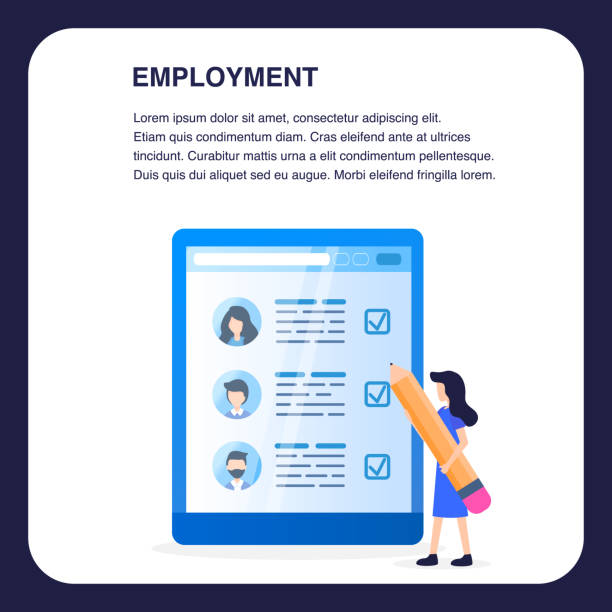Introduction to Responsive Website Design and its Importance in the Digital Age

In today’s world, where users access the web from diverse devices, #responsive_website_design or #responsive_design is no longer a luxury, but an undeniable necessity.
This approach in web design ensures that your website is displayed correctly and provides an optimal user experience (UX), regardless of the screen size of the user’s device, including smartphones, tablets, laptops, and even smart TVs.
The importance of this issue is such that search engines like Google prioritize responsive websites in their rankings.
Websites that offer a poor mobile user experience not only lose their SEO ranking but also experience a higher Bounce Rate.
Today, #mobile_traffic constitutes a large portion of web visitors, and this trend is growing.
Therefore, ignoring responsive design means losing a significant portion of potential audience.
Instead of building separate versions for each device, a responsive site adapts itself to the screen size and resolution using a single codebase.
This approach not only reduces development and maintenance costs but also makes content updates easier.
In fact, responsive website design is a long-term investment for the online success of your business.
This is especially crucial in e-commerce, where users expect to access products and services anytime, anywhere.
Did you know that most online purchases today are made via mobile devices? This is a thought-provoking content that businesses should consider.
In this article, we will specifically and explanatorily cover all aspects of responsive web design and introduce you to its principles, tools, and best practices.
The ultimate goal is for you to be able to build a website that is not only beautiful but also functions completely and flawlessly on any device.
Are you tired of losing business opportunities due to not having a professional corporate website?
RasaWeb helps you with professional corporate website design:
✅ Build a powerful and reliable brand image
✅ Convert website visitors into loyal customers
⚡ Get a free consultation now!
Core Principles of Responsive Design: A Detailed Look at Structures

At the heart of every successful #responsive_website_design lies a set of fundamental and vital principles that allow the website to adapt to different environments.
These principles include Flexible Grids, Fluid Images, and Media Queries.
These three essential pillars form the backbone of responsive design, and a thorough understanding of them is crucial for any web developer.
Flexible grids use relative units like percentages for element widths instead of fixed pixel units.
This means that the width of different columns and sections of the website changes proportionally to the screen size, instead of having a fixed size.
For example, if a column occupies 20% of the screen width, this 20% ratio is maintained across any screen size, so the content adjusts dynamically.
This educational approach allows designers to have more control over how elements are displayed in different environments.
Fluid images operate on the same logic.
Instead of defining fixed dimensions for images, the max-width: 100%; property in CSS is used.
This property ensures that the image never exceeds the width of its container and automatically scales to fit the available space.
This prevents images from being cut off or creating unwanted horizontal scrollbars on smaller devices.
Responsive website design without attention to image optimization can lead to poor user experience and slow site loading.
Finally, Media Queries are powerful tools in CSS3 that allow you to apply specific styles based on device characteristics such as screen width, height, orientation (portrait or landscape), resolution, and media type.
For example, you can define rules that if the screen width is less than 768 pixels, the navigation menu changes to a hamburger menu or font sizes become smaller.
This approach provides incredible flexibility in controlling the website’s appearance on different devices and is the cornerstone of a truly responsive website design.
Mastering these principles is your gateway to the world of modern web design.
Popular Tools and Frameworks for Responsive Design

To effectively implement #responsive_website_design, developers use a set of tools and frameworks that simplify and streamline the process.
Choosing the right tool can significantly impact development speed, code quality, and project flexibility.
In this section, we will introduce and review some of the most popular tools and frameworks.
Bootstrap is undoubtedly one of the most well-known and widely used front-end frameworks.
This framework provides a comprehensive set of HTML, CSS, and JavaScript components, including a responsive grid system, UI components (such as forms, buttons, navigation bars), and JavaScript plugins.
Bootstrap enables developers to quickly build responsive and modern websites.
Although it has a larger code footprint, it significantly accelerates development speed.
In addition to large frameworks, CSS itself has provided powerful capabilities for responsive design with features like Flexbox and CSS Grid.
Flexbox is ideal for designing one-dimensional layouts (like rows or columns) and easily allows for aligning, distributing space, and reordering elements.
In contrast, CSS Grid is a two-dimensional layout system designed for creating more complex arrangements with rows and columns.
The combined use of these two features brings unprecedented flexibility in responsive design, and many modern projects for responsive website design leverage them.
Here is a table comparing some popular tools:
| Tool/Framework Name | Type | Primary Use | Learning Curve |
|---|---|---|---|
| Bootstrap | CSS/JS Framework | Rapid development of responsive websites | Medium |
| Flexbox | CSS Feature | One-dimensional layouts and space distribution | Low |
| CSS Grid | CSS Feature | Complex two-dimensional layouts | Medium |
| Foundation | CSS/JS Framework | Building complex and customized websites | Medium to High |
Choosing the best tool depends on project needs and the development team’s skills.
Some projects may benefit from the flexibility and full control of CSS Grid and Flexbox, while others need the rapid development and ready-made components of Bootstrap.
Common Challenges in Implementing Responsive Design

Despite the numerous advantages of #responsive_website_design, its implementation is not always without challenges.
Developers encounter various obstacles during the design and implementation process that can affect performance, user experience, and even project timelines.
One of the biggest challenges is maintaining site loading speed across different devices, especially on mobile with limited internet.
High-quality images, multiple custom fonts, and heavy scripts can severely reduce loading speed.
Another challenge is content management and prioritizing its display for different screen sizes.
Some content elements that display well on desktop may occupy too much space or disrupt the user experience on mobile.
This is where the need for a precise content strategy for responsive website design becomes important.
It must be decided which information is more essential for the mobile user and how it can be presented concisely and effectively.
Testing and debugging across different environments is also one of the most complex stages.
Despite simulators and browser developer tools, nothing replaces testing on real devices with various operating systems and browsers.
Ensuring that the website works correctly on all target devices and browsers requires significant time and resources.
Display errors, issues with touch interactions, and layout inconsistencies are among the problems that may arise at this stage.
Furthermore, managing the complexity of CSS and JavaScript to handle different scenarios can be exhausting.
Excessive use of media queries or JavaScript code for layout adjustments can lead to code that is difficult to maintain and prone to errors.
Should a new breakpoint be defined for every screen size? This is a questionable content that requires an analytical approach.
The best solution is usually to use a limited number of breakpoints that provide the broadest coverage for common devices.
Overcoming these challenges requires deep knowledge, careful planning, and practical experience in mobile-friendly design.
Do you dream of a thriving online store but don’t know where to start?
RasaWeb is your comprehensive e-commerce website design solution.
✅ Attractive and user-friendly design
✅ Increased sales and revenue⚡ Get a free consultation now
Impact of Responsive Design on SEO and Google Ranking

In the digital age, #SEO (Search Engine Optimization) plays a vital role in the online success of any website.
Google and other search engines constantly update their algorithms to provide the best and most relevant results to users.
Among these, #responsive_website_design or #responsive_design is recognized as one of the most important ranking factors.
The main reason for this is #Google_mobile_first; meaning Google primarily examines the mobile version of your website for indexing and ranking.
If your website is not optimized for mobile, you will have little chance of achieving high rankings in search results.
A responsive website provides an improved user experience across all devices.
This, in turn, leads to a reduction in bounce rate, an increase in user dwell time on the site, and greater user engagement.
These positive signals are identified by Google’s algorithms and are considered indicators of content quality and relevance, ultimately helping to improve site ranking.
Specialized responsive website design can significantly boost these factors.
Furthermore, having only one URL for all versions of the website (instead of having m.site.com for mobile) simplifies the crawling and indexing process for search engines.
This prevents the creation of duplicate content and also makes managing links and backlinks easier.
In other words, all of your website’s SEO power is concentrated on one domain.
This is a significant advantage compared to separate mobile websites.
Google has explicitly stated responsive design as its recommended approach for building mobile-friendly websites.
This clear message to webmasters and business owners indicates that if they want to maintain or improve their position in search results, investing in responsive design is crucial.
From a news perspective, this change in algorithms began years ago and is still evolving, and every business should take it seriously.
Practical Solutions for Optimizing Images and Videos in Responsive Design

One of the biggest challenges in #responsive_website_design is managing #images_and_videos in a way that preserves visual quality while ensuring fast and optimized loading.
Images and videos are typically the heaviest elements of a web page, and inadequate optimization can severely impact loading speed and, consequently, user experience and SEO.
Fortunately, powerful practical solutions exist to address this challenge, helping you implement these visual elements efficiently in your responsive website.
For images, using the srcset and sizes attributes in the HTML <img> tag is a standard and highly effective solution.srcset allows the browser to have multiple versions of an image with different resolutions, and sizes informs the browser how much space the image will occupy in the layout.
By using these attributes, the browser can intelligently select the best image version based on the screen size and resolution of the user’s device, leading to faster loading and less data consumption.
This is a guidance and specialized approach for image optimization in responsive website design.
Furthermore, compressing images without noticeable quality loss and using next-generation image formats like WebP can significantly reduce image file sizes.
Lazy Loading is also a technique where images and videos are only loaded when they become visible within the user’s viewport.
This speeds up the initial page load, as unnecessary resources are not downloaded immediately.
Many JavaScript libraries and even native browser features (with loading="lazy") provide this capability.
For videos, Responsive Embeds are highly important.
This is typically done using CSS to maintain the video’s aspect ratio (e.g., 16:9 or 4:3) across different screen sizes.
You can make a video responsive by placing it in a container with position: relative; and setting padding-bottom based on the aspect ratio.
Also, using video players that are inherently responsive (like YouTube or Vimeo) or using the HTML5 <video> tag with multiple sources (<source>) for different formats helps with optimization.
Successful responsive website design is not possible without considering these points regarding visual content.
Case Study: Success of Responsive Design in Businesses

While #principles_of_responsive_website_design have important technical aspects, observing their real impact on businesses and their successes can be very #inspiring.
Many large and small companies, by implementing a professional #responsive_design, have witnessed significant growth in mobile traffic, increased conversion rates, and improved customer experience.
This section will discuss several successful case studies in a news and analytical manner.
One of the most prominent examples is Airbnb’s website.
This global accommodation rental platform, by implementing a flawless responsive website design, has made the booking experience equally smooth and enjoyable for both mobile and desktop users.
This has helped them attract millions of users worldwide and revolutionize the hospitality and tourism industry.
The ability to search, filter, and book through any device has been key to their success.
Another example is BBC News.
The BBC news website, with its vast amount of content, required a very precise approach to deliver news on various devices.
With responsive design, they have been able to ensure that readers, regardless of screen size, can easily access news, images and videos are scaled correctly, and the reading experience is enjoyable.
This has significantly helped maintain their wide and diverse audience.
In the e-commerce sector, ASOS, the online fashion retailer, is an excellent example of the impact of responsive design.
Given that a large portion of online fashion purchases are made via mobile, ASOS has not only improved the shopping experience but also increased its conversion rate by optimizing its site for mobile devices.
This includes easy navigation, high-quality product images that scale correctly, and a simple and fast checkout process.
These examples demonstrate that responsive website design is not just a technical approach but a business strategy that can directly impact revenue, customer satisfaction, and market share.
Here is a table of general benefits observed in these cases:
| Success Factor | Description | Impact on Business |
|---|---|---|
| Increased Mobile Traffic | Website provides a good mobile experience. | Access to a larger audience segment. |
| Improved Conversion Rate | Users more easily make purchases or complete forms. | Increased sales and revenue. |
| Reduced Bounce Rate | Users stay on the site for a longer duration. | Indicates user satisfaction and relevant content. |
| Improved SEO | Higher ranking in Google search results. | Increased visibility and organic traffic. |
These examples clearly demonstrate that investing in a responsive web design is not only essential but can also bring significant commercial benefits.
The Future of Web Design and the Role of Responsiveness

The world of #web_design is rapidly evolving, and we are constantly witnessing the emergence of new technologies and approaches.
However, despite these changes, #responsiveness and #mobile_compatibility will not only maintain their importance but will play a more central role in the future.
As new devices with diverse sizes and capabilities enter the market, the need for websites that can adapt to any environment is increasingly felt.
This is an analysis of the future that must be taken seriously.
One trend shaping the future of #responsive_website_design is the expansion of #Progressive_Web_Apps (PWAs).
PWAs offer a native app-like experience through the web browser and can work offline, send notifications, and even be installed as an icon on the device’s home screen.
These technologies require a responsive and reliable foundation to function well on any device and provide a seamless user experience.
The Internet of Things (IoT), with the proliferation of smart devices such as smartwatches, connected home appliances, and even cars, brings new challenges and opportunities for #responsive_design.
Websites and applications in the future must be able to optimize content not only for small or large screens but also for completely different, screen-less environments.
This means going beyond merely resizing and moving towards designs that are truly “responsive” to their surrounding environment.
New CSS technologies like Container Queries (which respond to the size of the parent container instead of the entire page) and Logical Properties also give developers more control over responsive layouts.
These tools enable more modular and maintainable designs.
It seems that in the future, the concept of responsive website design will be less about responding to screen size and more about responding to different user needs and environments.
This is a paradigm shift that every developer should be prepared for.
Are you ready for this exciting future? This thought-provoking content makes you think.
Is your online sales not meeting your expectations? With RasaWeb, solve the problem of low sales and poor user experience forever!
✅ Increase visitor-to-customer conversion rate
✅ Create an enjoyable user experience and build customer trust
⚡ Act now for a free consultation!
Important Tips for Testing and Debugging Responsive Design

Implementing #responsive_website_design is only half the battle; the other equally crucial part is #testing_and_debugging it.
Ensuring that your website functions correctly across all devices, browsers, and screen sizes requires a systematic and precise approach.
Neglecting this stage can lead to poor user experience, display errors, and even loss of customers.
The first and most widely used tool for testing is #browser_developer_tools.
Virtually all modern browsers (such as Chrome, Firefox, Edge, and Safari) have built-in tools that allow you to simulate your website in various device modes.
These tools enable you to change screen size, activate #mobile_simulation, test touch interactions, and even simulate network conditions to see how your site performs at different internet speeds.
This is an initial and educational guide to get started.
However, simulators cannot completely replace testing on #real_devices.
There are differences in rendering engines, browser behavior, graphics processors, and even touch responsiveness on real devices that simulators cannot fully replicate.
Therefore, dedicating time to testing on a range of smartphones, tablets, and laptops with different operating systems (iOS, Android, Windows, macOS) and various browsers (Chrome, Safari, Firefox, Edge) is crucial.
This will help you discover unexpected problems in your responsive website design.
Online responsive testing tools can also be helpful.
Websites like #ResponsivelyApp or #Am_I_Responsive allow you to view your website simultaneously across multiple screen sizes.
While these tools are suitable for quick layout checks, for deeper testing and more complex interactions, you still need manual testing.
Finally, paying attention to #breakpoints in CSS and ensuring that content and layout are correctly adjusted at each of these points is very important.
Also, checking loading speed at each breakpoint and optimizing images and scripts for each device is an integral part of successful #responsive_design debugging.
An excellent responsive website design is guaranteed by thorough testing and debugging.
Summary and Final Recommendations for a Flawless Responsive Design

As thoroughly discussed in this article, #responsive_website_design is no longer a luxury choice but a vital requirement for the success of any website in the current era.
From improving #user_experience and #SEO_improvement to reducing maintenance costs and expanding audience reach, the benefits of a responsive design are undeniable.
Achieving a flawless #responsive_design requires a comprehensive approach and adherence to best practices.
The first recommendation is to always keep #mobile_first_thinking in mind.
Instead of designing for desktop and then trying to condense it for mobile, start your design process with the smallest screen.
This approach forces you to think about the core content and functionality from the outset and to focus on the user experience on mobile devices.
This is an explanatory recommendation for an efficient #responsive_website_design.
Second, pay special attention to your site’s #performance.
Even the best responsive design will lose users if it loads slowly.
Optimizing images, using lazy loading, reducing HTTP requests, and compressing code are among the actions that help increase loading speed.
Tools like Google PageSpeed Insights can help you identify performance bottlenecks.
Third, #test_your_website regularly.
The ecosystem of devices and browsers changes rapidly, so a website that looks great today may face problems tomorrow.
Continuous testing on real devices and simulators is key to maintaining quality and a desirable user experience.
Finally, always seek #education and #knowledge_update in the field of responsive website design.
New CSS technologies like Container Queries, new HTML features, and JavaScript are constantly evolving.
By staying up-to-date with these advancements, you can build websites that are not only flawless now but will also be robust and adaptable for the future.
Learning and practice will help you on your path to becoming a successful responsive web designer.
Your success on this path can be very entertaining and enjoyable for you.
Frequently Asked Questions
| Question | Answer |
|---|---|
| What is responsive website design? | A web design method that automatically adjusts and optimizes the layout and content of a site for display on different devices (mobile, tablet, desktop). |
| Why is responsive design important? | Due to the variety of devices users employ to access the web; it offers a better user experience, stronger SEO, and reduces user bounce rate. |
| What are the main techniques in responsive design? | Using Media Queries in CSS, Fluid Grids, and Flexible Images. |
| What is a Media Query? | A CSS rule that allows you to apply different styles based on device characteristics (such as screen width, height, display orientation). |
| Is responsive design different from Mobile-First design? | Mobile-First is an approach within responsive design that initially designs the site for the smallest screen (mobile) and then gradually enhances it for larger screens. |
And other services of RasaWeb Advertising Agency in the field of advertising
Methods of direct interaction with customers through online advertising
How to give a unique personality to your online advertisements and stand out
Review of successful patterns in online beverage advertisements
The role of technical information in attracting professional customers through advertising
How to use customer feedback to improve online advertisements
And over hundreds of other services in the field of online advertising, advertising consultation, and organizational solutions
Online Advertising | Advertising Strategy | Advertorials
🎯 Are you ready to revolutionize your business in the digital world? RasaWeb Digital Marketing Agency, with expertise in modern UI website design, SEO, and content marketing strategies, paves your path to online success.
📍 Tehran, Mirdamad Street, next to Bank Markazi, Kazeroun Jonoubi Alley, Ramin No. 6




